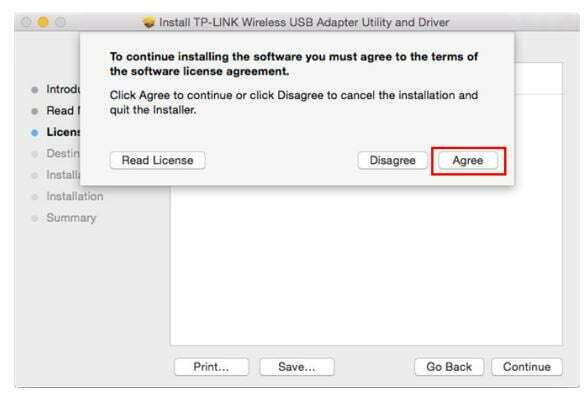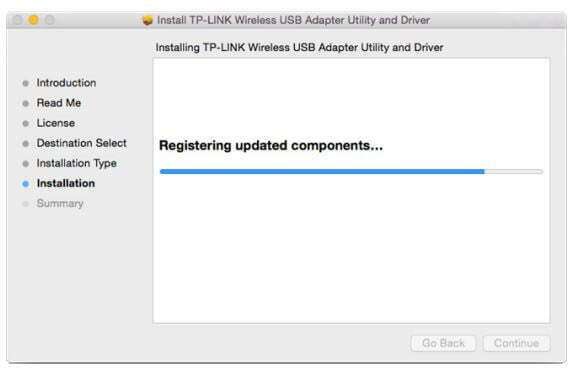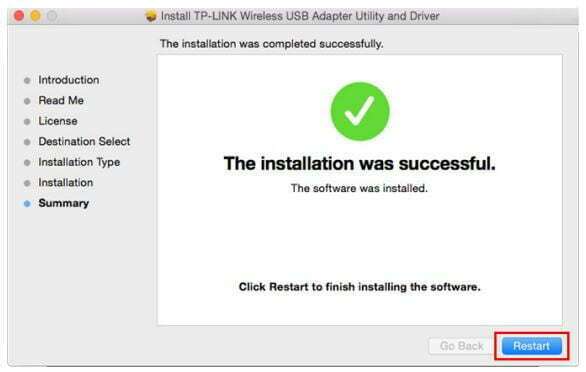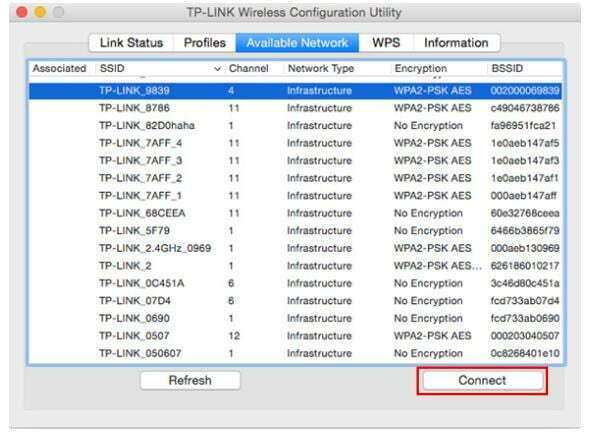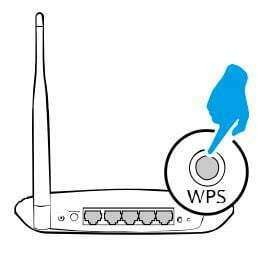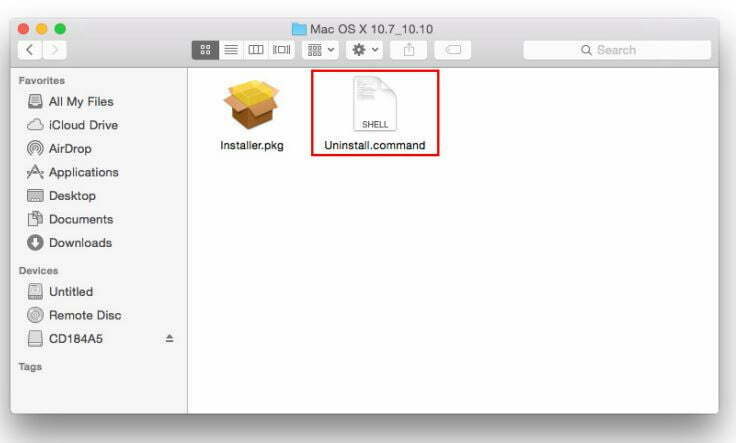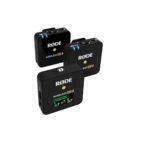TP-Link TL-WN823N 300Mbps Mini Wireless
N USB Adapter User Manual
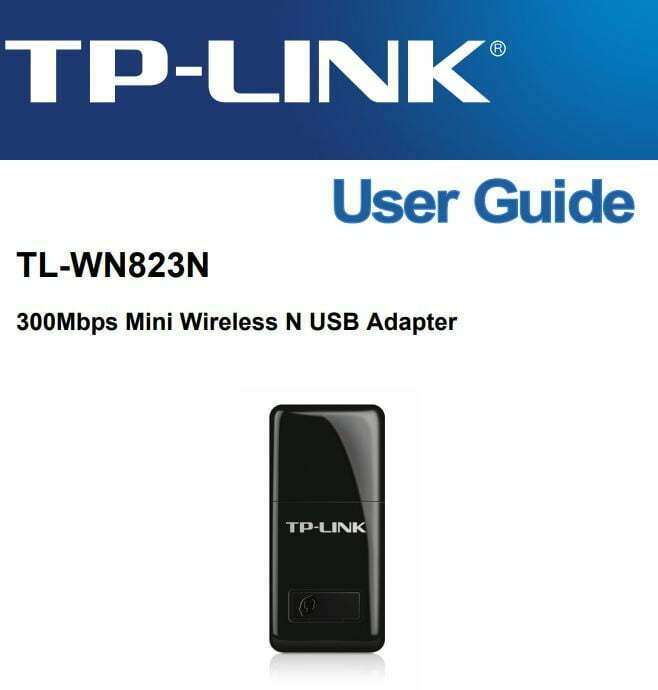
COPYRIGHT & TRADEMARKS
Specifications are subject to change without notice. TP-LINK is a registered trademark of TP-LINK TECHNOLOGIES CO., LTD. Other brands and product names are trademarks or registered trademarks of their respective holders.
No part of the specifications may be reproduced in any form or by any means or used to make any derivative such as translation, transformation, or adaptation without permission from TP-LINK TECHNOLOGIES CO., LTD. Copyright © 2016 TP-LINK TECHNOLOGIES CO., LTD. All rights reserved.
http://www.tp-link.com
FCC STATEMENT
![]() This equipment has been tested and found to comply with the limits for a Class B digital device, pursuant to part 15 of the FCC Rules. These limits are designed to provide reasonable protection against harmful interference in a residential installation. This equipment generates, uses and can radiate radio frequency energy and, if not installed and used in accordance with the instructions, may cause harmful interference to radio communications. However, there is no guarantee that interference will not occur in a particular installation. If this equipment does cause harmful interference to radio or television reception, which can be determined by turning the equipment off and on, the user is encouraged to try to correct the interference by one or more of the following measures:
This equipment has been tested and found to comply with the limits for a Class B digital device, pursuant to part 15 of the FCC Rules. These limits are designed to provide reasonable protection against harmful interference in a residential installation. This equipment generates, uses and can radiate radio frequency energy and, if not installed and used in accordance with the instructions, may cause harmful interference to radio communications. However, there is no guarantee that interference will not occur in a particular installation. If this equipment does cause harmful interference to radio or television reception, which can be determined by turning the equipment off and on, the user is encouraged to try to correct the interference by one or more of the following measures:
- Reorient or relocate the receiving antenna.
- Increase the separation between the equipment and receiver.
- Connect the equipment into an outlet on a circuit different from that to which the receiver is connected.
- Consult the dealer or an experienced radio/ TV technician for help.
This device complies with part 15 of the FCC Rules. Operation is subject to the following two conditions:
- This device may not cause harmful interference.
- This device must accept any interference received, including interference that may cause undesired operation.
Any changes or modifications not expressly approved by the party responsible for compliance could void the user’s authority to operate the equipment.
Note: The manufacturer is not responsible for any radio or TV interference caused by unauthorized modifications to this equipment. Such modifications could void the user’s authority to operate the equipment.
FCC RF Radiation Exposure Statement
This equipment complies with FCC RF radiation exposure limits set forth for an uncontrolled environment. This device and its antenna must not be co-located or operating in conjunction with any other antenna or transmitter.
“To comply with FCC RF exposure compliance requirements, this grant is applicable to only Mobile Configurations. The antennas used for this transmitter must be installed to provide a separation distance of at least 5 mm from all persons and must not be co-located or operating in conjunction with any other antenna or transmitter.”
CE Mark Warning
![]() 1588
1588
This is a class B product. In a domestic environment, this product may cause radio interference, in which case the user may be required to take adequate measures.
RF Exposure Information
This device meets the EU requirements (1999/5/EC Article 3.1a) on the limitation of exposure of the general public to electromagnetic fields by way of health protection.
This device has been tested and meets the ICNIRP exposure guidelines and the European Standard EN 62209-2. SAR is measured with this device at a separation of 0.5 cm to the body, while transmitting at the highest certified output power level in all frequency bands of this device. Carry this device at least 0.5 cm away from your body to ensure exposure levels remain at or below the as-tested levels.
Canadian Compliance Statement
This device complies with Industry Canada license-exempt RSS standard(s). Operation is subject to the following two conditions:
(1) This device may not cause interference, and
(2) This device must accept any interference, including interference that may cause undesired operation of the device.
Radiation Exposure Statement:
This equipment complies with IC radiation exposure limits set forth for an uncontrolled environment. This equipment should be installed and operated with minimum distance 20cm between the radiator & your body.
Industry Canada Statement
CAN ICES-3 (B)/NMB-3(B).
Safety Information
- When product has power button, the power button is one of the way to shut off the product; when there is no power button, the only way to completely shut off power is to disconnect the product or the power adapter from the power source.
- Don’t disassemble the product, or make repairs yourself. You run the risk of electric shock and voiding the limited warranty. If you need service, please contact us.
- Avoid water and wet locations.
Explanation of the symbols on the product label
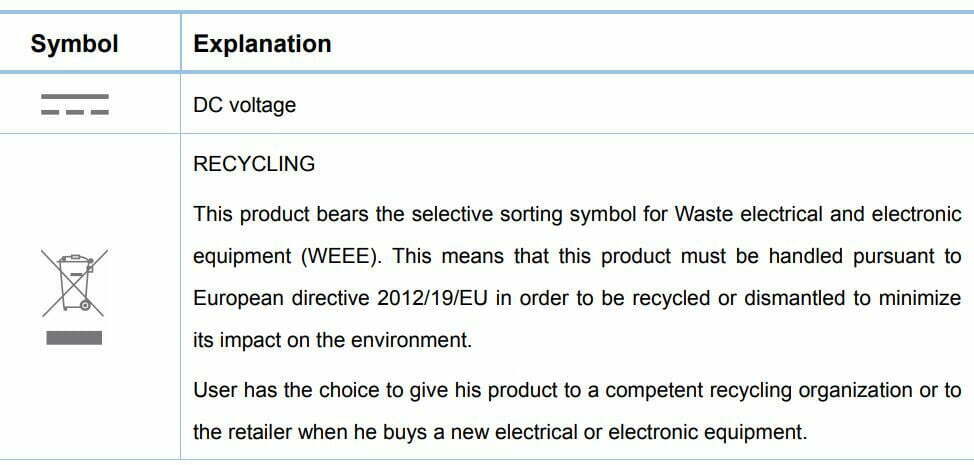
DECLARATION OF CONFORMITY
For the following equipment:
Product Description: 300Mbps Mini Wireless N USB Adapter
Model No.: TL-WN823N
Trademark: TP-LINK
We declare under our own responsibility that the above products satisfy all the technical regulations applicable to the product within the scope of Council Directives:
Directives 1999/5/EC, Directives 2014/30/EU, Directives 2014/ 35/EU, Directives 2011/65/EU
The above product is in conformity with the following standards or other normative documents:
EN 300 328 V1.9.1
EN 301489-1 V1.9.2 & EN 301489-17 V2.2.1
EN 55022: 2010+AC: 2011
EN 55024: 2010
EN 60950-1: 2006 + A11: 2009 + A1: 2010 + A12: 2011 +A2: 2013
EN 50566: 2013
EN 50581: 2012

TP-LINK TECHNOLOGIES CO., LTD.
Building 24 (floors 1, 3, 4, 5), and 28 (floors 1-4) Central Science and Technology Park,
Shennan Rd, Nanshan, Shenzhen, China
Chapter 1 Product Overview
1.1 Introduction
The TP-LINK TL-WN823N 300Mbps Mini Wireless N USB Adapter connects your notebook or desktop computer over Wi-Fi to an 11n or other network for applications such as lag-free video streaming, online gaming, and secure Internet surfing.
1.2 Features
- Complies with IEEE 802.11n, IEEE 802.11g, IEEE 802.11b standards
- Supports WPA/WPA2 data security, IEEE802.1x authentication, TKIP/AES encryption, WEP encryption
- Supports high rate of up to 300Mbps for maximum throughput, supports automatically adjust to lower speeds due to distance or other operating limitations
- Provides USB 2.0 interface
- Supports Ad Hoc and Infrastructure modes
- Good capability on anti-jamming
- Supports roaming between access points when configured under Infrastructure mode
- Easy to configure and provides monitoring information
- Provides internal antennas
- Supports Windows XP/7/8/8.1/10 32/64bit, Mac OS X 10.7 – 10.10, Linux
1.3 LED Status

Note:
When the card failed to connect to a wireless network, the LED may be off. Please choose your network and try to connect again.
Chapter 2 Connect to a Computer
- Locate an available USB interface on your computer.
- Connect the adapter and your computer with the USB Adapter.

Note:
- In Windows XP, a Found New Hardware Wizard window will appear when the adapter is detected. Please click Cancel.
After connecting your adapter to the computer, please follow the instructions in the appropriate chapter for your operating system: Windows, Mac OS X, Linux.
Chapter 3 Windows
3.1 Install Driver
The Setup Wizard will guide you through the installation procedures. We use the procedures in Windows 7 as an example – the procedures may vary slightly for other versions of Windows.
- Insert the resource CD into your CD drive and run the Autorun.exe from the pop-up AutoPlay window. Select TL-WN823N and click Install Driver to begin.

Note:
• The CD is included in the package. If your CD does not work or your computer doesn’t support the CD, you can also download the driver and utility from the TP-LINK website (http://www.tp-link.com).
• In some operating systems, the CD screen will pop up automatically. Otherwise, run the CD manually. - The InstallShield Wizard window displays. Click Next to continue

- Choose a setup type. It is recommended to select Install Driver Only. Click Next.
 Note:
Note:
The default setup type is Install Driver Only. You can also select Install TP-LINK Wireless Configuration Utility and Driver for more functions, such as joining a wireless network via TP-LINK Utility or WPS, and managing the adapter. - Click Install. After a few minutes, the installation completes. Click Finish.
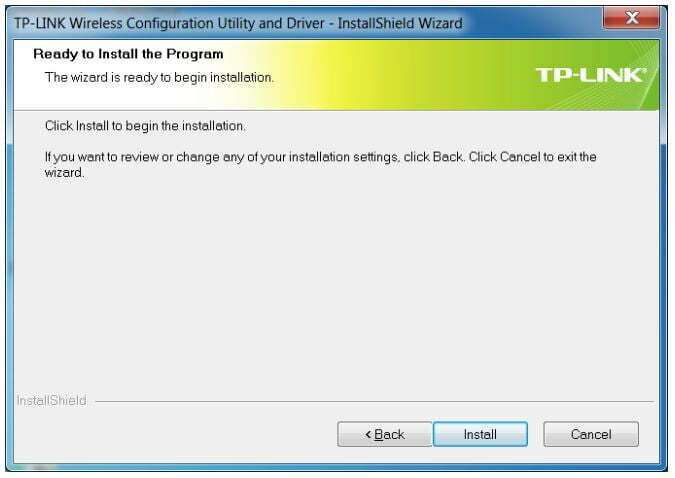
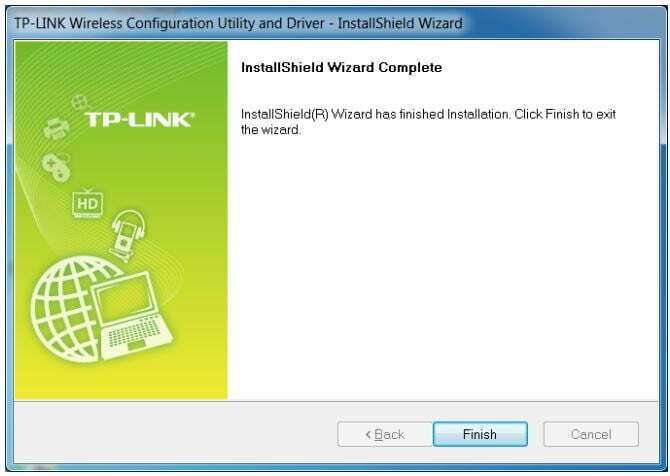
3.2 Join a Wireless Network
You can join a wireless network via Windows built-in Wireless Utility. If you want to use Option 2: TP-LINK Utility or Option 3: WPS (Wi-Fi Protected Setup) to join a wireless network, you need to install TP-LINK Utility first.
Option 1: Windows Wireless Utility
You can use the Windows WLAN Autoconfig service (for Windows 7/8/8.1/10) and the Wireless Zero Configuration service (for Windows XP) to join a Wi-Fi network.
Option 2: TP-LINK Utility
TP-LINK Utility lets you easily connect the adapter to a Wi-Fi network and manage the adapter.
Option 3: WPS (Wi-Fi Protected Setup)
WPS (Wi-Fi Protected Setup) is a network security standard for easily adding computers and other devices to a home network. Use this method if your wireless router or access point supports WPS.
3.2.1 Windows Wireless Utility
Follow the instructions in the appropriate section below to use your computer system’s built-in wireless utility: Windows 7/8/8.1/10, Windows XP

Note:
If you do not want to enter the Wi-Fi password, you can also join a wireless network either by pushing the WPS or QSS button on your router or AP, or entering the PIN of your router when the screen prompts you to do so, and click Next.
Windows XP
1. If you have not installed TP-LINK Utility, please directly go to Step 2. If you have installed TP-LINK Utility, you need to switch to use Windows wireless configuration tool manually using one of the following methods.


3.2.2 TP-LINK Utility
- Double-click
 (TP-LINK Utility icon). The Network screen displays.
(TP-LINK Utility icon). The Network screen displays.

- Select the network you want to join from the list on this screen and click Connect. If you want the adapter to automatically connect to the network next time, select the Connect automatically checkbox. Enter your Wi-Fi password when prompted.
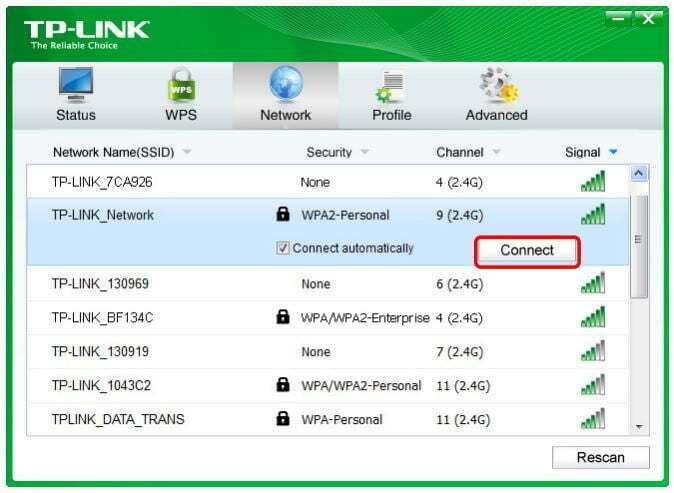
Note:
If your Wi-Fi network is not displayed in the list, you can try to join it by WPS or by adding a profile in the Profile screen.
3.2.3 WPS (Wi-Fi Protected Setup)
WPS can be activated via PBC (Push Button Configuration) and PIN code. Please refer to PBC or PIN below.
PBC
Option 1
- Press the WPS/QSS button on your router or AP. Within 2 minutes, press and hold the WPS button on the adapter until the following screen appears.


- The following screen indicates a successful connection by WPS. Click OK.

Option 2
- Press the WPS/QSS button on your router or AP.

- Open TP-LINK Utility and click WPS tab. Select Push the button on my access point or wireless router and click Connect.

- The following screen indicates a successful connection by WPS. Click OK.

PIN
Option 1
- Open TP-LINK Utility and click WPS tab. Select Enter the PIN of my access point or wireless router. Enter the PIN of your router or AP. Click Connect.

Note:
The default PIN of your router or AP is printed on the product label of your router or AP. If you generated a new PIN for your router, please enter the new one. - The following screen indicates a successful connection by WPS. Click OK.

Option 2
- Open TP-LINK Utility and click WPS tab. Select Enter the PIN of this device into my access point or wireless router. The screen displays a PIN of the adapter, which is generated randomly. Click Connect.

- Log into the Web Management page of your router or AP. Go to the WPS page, enter the PIN of the adapter in the corresponding field and click Connect.
- The following screen indicates a successful connection by WPS. Click OK.

3.3 Management
TP-LINK Utility provides you with an easy way to manage your adapter. It includes the following sections:
Status – View the information of the current Wi-Fi network connection and of the adapter.
Profile – Save or manage various Wi-Fi network connection settings.
Advanced – Turn on or off the SoftAP mode and power saving mode, switch between TP-LINK Utility and Windows Wireless Utility (for Windows XP only).
SoftAP – Configure the settings of the network shared by your adapter, and view the IP address of your adapter when it works on SoftAP mode.
About – View your adapter’s Utility version and its Driver version
Double-click ![]() (TP-LINK Utility icon) and click the Status, Profile or Advanced tab to manage the corresponding section of your adapter.
(TP-LINK Utility icon) and click the Status, Profile or Advanced tab to manage the corresponding section of your adapter.
3.3.1 Status
You can view the IP address and MAC address of the adapter, the signal strength of the Wi-Fi network, and other information of the network status as shown in the following figure.

3.3.2 Profile
The Profile screen lets you save and manage different Wi-Fi network connection settings as profiles so that you can quickly and simply connect to your network. Moreover, you can join a hidden Wi-Fi network that does not broadcast its SSID by adding a profile, provided that you know its wireless settings, such as SSID, security type, and encryption type. For more details, please refer to the instructions below: To add a new profile, To join a Wi-Fi network, To manage an existing profile.

To add a new profile
- Click the Add button, and then a new window will open.
- Complete the settings as shown in the following figure, and click Save.

Profile Name – Enter a name for your profile, such as Home, Office, Coffeehouse. Do not enter the profile name that already exists.
SSID – Select your Wi-Fi network from the drop-down list or enter your Wi-Fi network name manually.
Network Type – Select Infrastructure if you want to connect to a wireless router or an access point. Select ad hoc if you want to connect to another wireless client, such as an adapter.
- Infrastructure
If you select Infrastructure, you are asked to select or enter the corresponding wireless settings, which should be the same as those of your Wi-Fi network. - ad hoc
If you select ad hoc, you are asked to configure the wireless settings for your network, including choosing the operating frequency band, the security type, the encryption type and setting a security key.

Note:
As for Key Index, you can select ASCII or Hexadecimal format from the drop-down list.
ASCII_64 – Please enter 5 ASCII characters.
ASCII_128 – Please enter 13 ASCII characters.
Hexadecimal_64 – Please enter 10 Hexadecimal digits (any combination of 0-9, a-f, A-F, excluded space).
Hexadecimal_128 – Please enter 26 Hexadecimal digits (any combination of 0-9, a-f, A-F excluded space).
To join a Wi-Fi network
If you want to join a Wi-Fi network that listed in the profile screen, select the profile and click Connect button in the bottom corner.
To manage an existing profile
If you want to change the name or the the Modify button in the Profile screen, then you can edit the settings of this profile. If you want to delete a profile that you no longer use, select it and click the Remove button.
3.3.3 Advanced

Select wireless configuration tool – In Windows XP. You can either use TP-LINK Utility or Windows wireless configuration tool. While in other operating systems, since you can use both TP-LINK Utility and Windows wireless configuration tool at the same time, this function is disabled.
Wireless network adapter switch – If you’ve installed several adapters in your computer, you can switch to another adapter among the drop-down list.
SoftAP mode – Once ON is selected, the adapter will work as an AP.
Power Save mode – Once ON is selected, the adapter will automatically reduce its power consumption when not being used.
3.3.4 SoftAP
SoftAP is short for Software enabled Access Point. When the adapter works in SoftAP mode, it allows the computer to create a wireless hotspot that other wireless devices nearby can use. To switch to SoftAP mode, right-click the utility icon on the taskbar and select Switch to SoftAP mode.
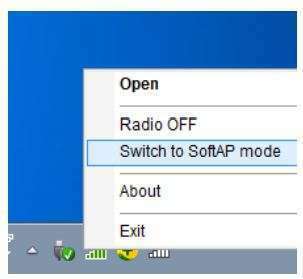
After switching to SoftAP mode, the SoftAP icon appears in the utility. Click the SoftAP tab, and complete the settings, then click Apply for the settings to take effect.

- Soft AP mode: Select ON or OFF to enable or disable this function.
- Internet Connecting Share(ICS): Select a network connection that can access to the Internet from the drop-down list. For example, if your computer is connecting to the Internet via an Ethernet cable, you should select the corresponding Local Area Connection so as to share the network with other wireless devices.
- SSID: Set a name for the wireless network shared by your adapter. The default is SoftAP.
- Security Type: The security type here is set to be WPA2-PSK which is based on 802.11i and uses AES (Advanced Encryption Standard).
- Encryption Type: The encryption type here is set to be AES.
- Security Key: Set a security key for the wireless network that shared by your adapter. It is recommended that you specify another key instead of the default key 12345678. When another wireless device connects to the network shared by your adapter, it will be asked to enter the corresponding security key.
- IP Address: Displays the IP address of the adapter when it works in SoftAP mode. You can also check if the network shared by your adapter is working properly by checking this IP Address. For example, if the IP Address is 0.0.0.0, it means that the Internet connection is failed.
3.3.5 About
You can view the adapter’s information in the About screen, such as the UI version (Utility version) and the Driver version. Right-click ![]() (TP-LINK Utility icon) on the taskbar and select About, then the About screen displays.
(TP-LINK Utility icon) on the taskbar and select About, then the About screen displays.

3.4 Uninstall Driver and Utility
The software uninstallation steps vary a bit in different systems, please follow the appropriate instructions for your Windows operating system: Windows 8/8.1/10, Windows XP/7.
- Windows 8/8.1/10
Uninstall driver:
Go to Start > Apps or All Apps, and find the TP-LINK application. Click Uninstall – TP-LINK TL-WN823N Driver, then follow the on-screen instructions to complete the uninstallation.
Uninstall utility:
Go to Start > Apps or All Apps, and find the TP-LINK application. Click Uninstall – TP-LINK Wireless Configuration Utility, then follow the on-screen instructions to complete the uninstallation.
- Windows XP/7
Uninstall driver:
Go to Start > All Programs > TP-LINK > Uninstall – TP-LINK TL-WN823N Driver. Follow the on-screen instructions to complete the uninstallation.
Uninstall utility:
Go to Start > All Programs > TP-LINK > Uninstall – TP-LINK Wireless Configuration Utility. Follow the on-screen instructions to complete the uninstallation.
Chapter 4 Mac OS X
4.1 Install Driver and Utility
We take the procedures in Mac OS X 10.10 as an example – the procedures may vary slightly for other versions of Mac OS.
- Insert the CD and run it manually. Open the TL-WN823N folder.

Note:
The CD is included in the package. If your CD does not work or your computer doesn’t support the CD, you can also download the driver and utility from the TP-LINK website (http://www.tp-link.com). - Open the Mac OS X Driver folder.

- Double-click the Mac OS X Version.zip file. It will be unzipped into the Download folder automatically.

- Open the Mac OS X Version folder, double click the Installer.pkg file to open the installation wizard.

- The Install TP-LINK Wireless USB Adapter Utility and Driver Wizard window will appear. Click Continue and follow the wizard to continue the installation.

 Note:
Note:
The language of this utility is in accordance with the language of your computer by default, and any change of it is invalid.




- After restarting the computer, the TP-LINK utility will pop up automatically. You can use the utility to join a Wi-Fi network with your adapter. For more guidance, please refer to Join a Wireless Network.

Note:
If the TP-LINK Utility does not pop up automatically, make sure the USB wireless network adapter is connected properly and the LED is on.
4.2 Join a Wireless Network
There are two options of using the adapter to join a Wi-Fi network.
Option 1: TP-LINK Utility
TP-LINK Utility lets you easily connect the adapter to a Wi-Fi network and manage the adapter.
Option 2: WPS (Wi-Fi Protected Setup)
WPS (Wi-Fi Protected Setup) is a network security standard for easily adding computers and other devices to a home network. Use this method if your wireless router or access point supports WPS.
4.2.1 TP-LINK Utility
- Open TP-LINK Utility
 and select Available Network tab. Then select the network you want to join from the list and click Connect.
and select Available Network tab. Then select the network you want to join from the list and click Connect.

- The wireless network security properties screen displays. If your network uses wireless security, you will be prompted to enter the Wi-Fi password of the network in the blank field next to Network key, and enter it again in the blank field next to Confirm network key. Click OK.

- After successfully connecting to your network, it will switch to Link Status screen automatically, which will show the network status. If you select Available Network tab, you will see a symbol in front of your network’s SSID, which indicates a successful connection.
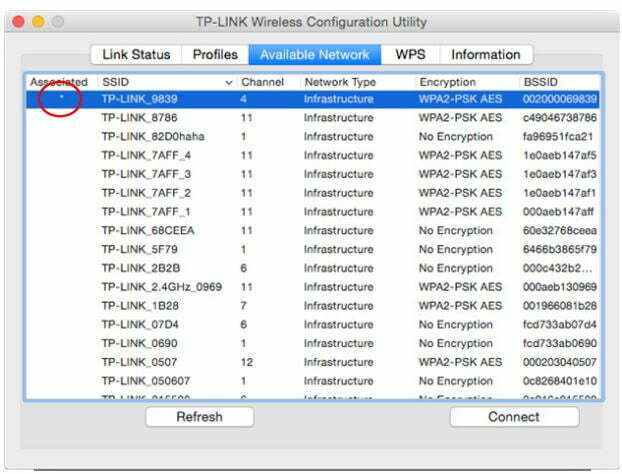
4.2.2 WPS (Wi-Fi Protected Setup)
WPS can be activated via PBC (Push Button Configuration) and PIN. Please refer to PBC or PIN below.
PBC
Option 1
- Press the WPS/QSS button on your router or AP. Within 2 minutes, press and hold the WPS button on the adapter until the following screen appears.


- The following screen indicates a successful connection by WPS. Click OK.

Option 2
- Press the WPS/QSS button on your router or AP.

- Within 2 minutes, open TP-LINK Utility and click WPS tab. Click PBC.

- The following screen indicates a successful connection by WPS. Click OK.

PIN
- Open TP-LINK Utility and click WPS tab. Mark down the PIN displayed on the screen, and click PIN.

- Within 2 minutes, log in to the Web Management page of your router or AP. Go to its WPS page, enter the PIN of the adapter in the corresponding field and click Connect.
- The following screen indicates a successful connection by WPS. Click OK.

4.3 Management
TP-LINK Utility provides you with an easy way to manage your adapter. It includes the following sections:
Link Status – View the information of the current Wi-Fi network connection and of the adapter.
Profiles – Save or manage various Wi-Fi network connection settings.
Information – View the utility version and the driver version of your adapter. Open TP-LINK Utility and click the Link Status, Profiles or Information tab to manage the corresponding section of your adapter.
4.3.1 Link Status
You can view the signal strength of the Wi-Fi network, the MAC address of the adapter and other information of the link status as shown in the following figure.
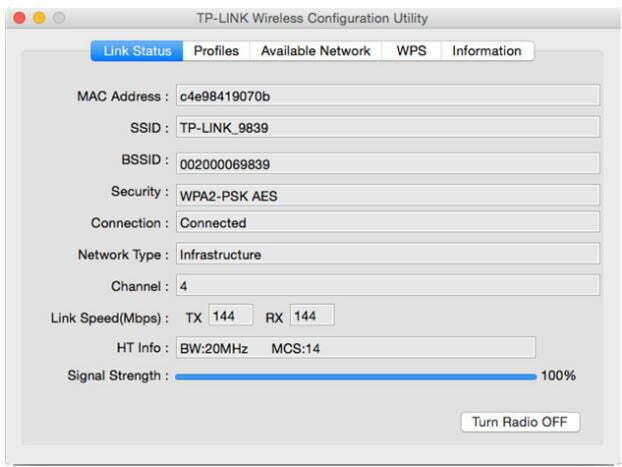
4.3.2 Profiles
The Profiles screen lets you save and manage different Wi-Fi network connection settings as profiles so that you can quickly and simply connect to your network. Moreover, you can join a hidden Wi-Fi network that does not broadcast its SSID by adding a profile, provided that you know its wireless settings, such as SSID, security type, and encryption type. For details, please refer to the instructions below: To add a new profile, To join a Wi-Fi network, To manage an
existing profile.
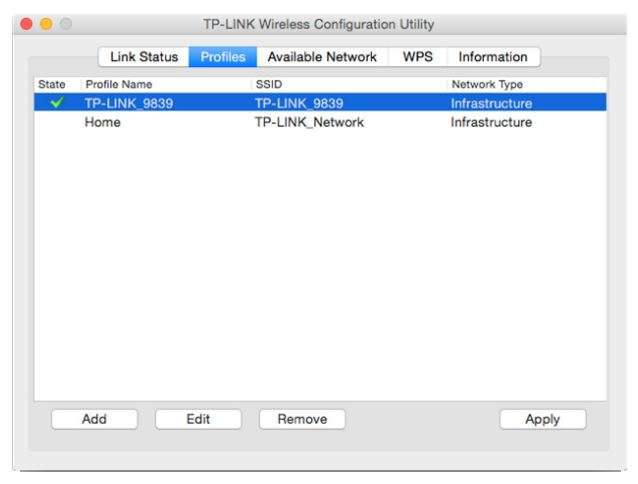
To add a new profile
- Click the Add button, and then a new window will open.
- Complete the settings as shown in the following figure, and click OK.
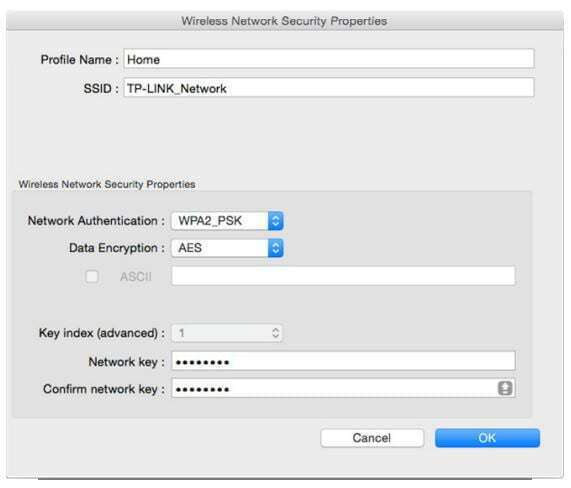
Profile Name – Enter a name for your profile, such as Home, Office, Coffeehouse. Do not enter the profile name that already exists.
SSID – Enter the name of your Wi-Fi network.
Wireless Network Security Properties: Select or enter the corresponding wireless settings, including Network Authentication, Data Encryption and Network key, which should be the same as those of your Wi-Fi network. Then click OK
To join a Wi-Fi network
If you want to join a Wi-Fi network that listed in the profile screen, select the profile and click Apply button in the bottom corner.
To manage an existing profile
If you want to change the name or the wireless settings of an existing profile, select it and click the Edit button in the Profile screen, then you can edit the settings of this profile. If you want to delete a profile that you no longer use, select it and click the Remove button.
4.4 Uninstall Driver and Utility
- Insert the CD and run it manually. Insert the CD and run it manually.
- Go to 2. Go to TL-WN823N > Mac OS X Driver > Mac OS X Version.zip > Uninstall. command.

- A command window will pop up, please type the password of the root user to uninstall the software.
- Wait till the “Process completed” shows up, then restart your computer to finish the uninstallation.
Note:
The CD is included in the package. If your CD does not work or your computer doesn’t support the CD, you can also download the driver and utility from the TP-LINK website (http://www.tp-link.com).
Chapter 5 Linux
Please visit the TP-LINK support website, find and download the compatible version of driver for your TL-WN823N at http://www.tp-link.com.
Appendix A: Specifications
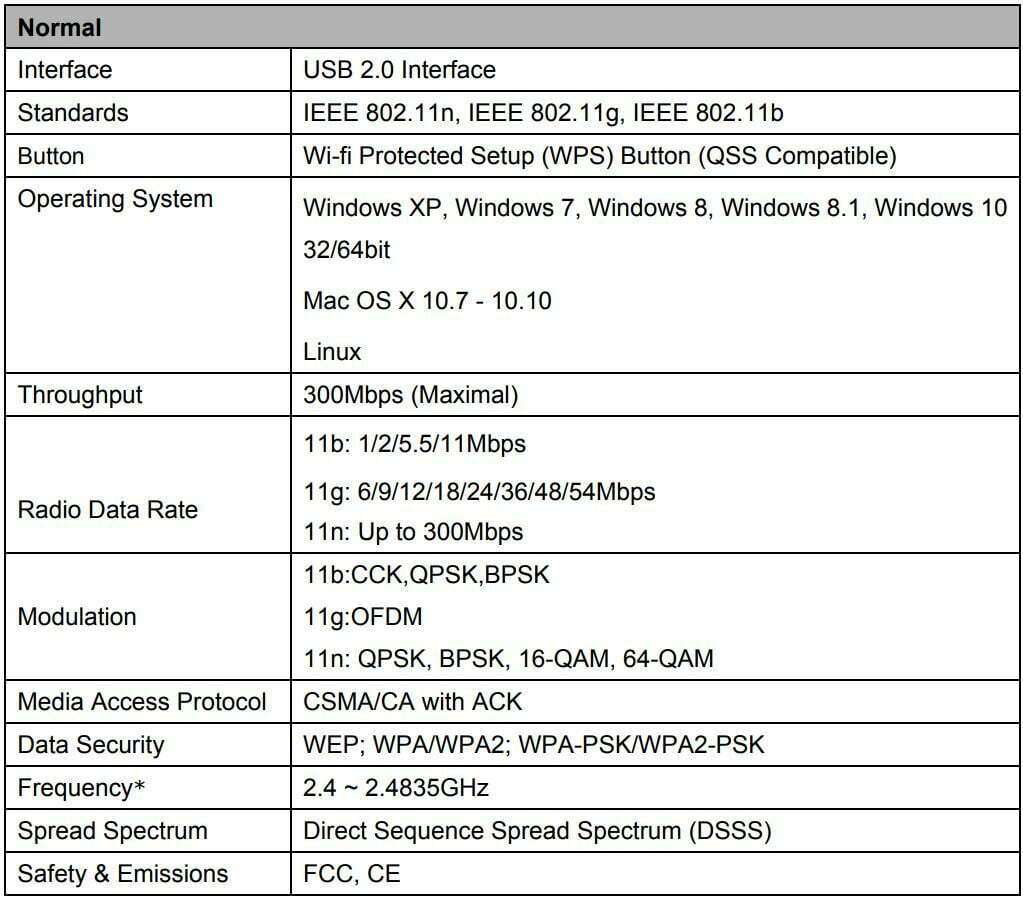

* Only 2.412GHz~2.462GHz is allowed to be used in USA, which means only channel 1~11 is available for American users to choose.
Appendix B: Glossary
- 802.11b – The 802.11b standard specifies a wireless product networking at 11 Mbps using direct-sequence spread-spectrum (DSSS) technology and operating in the unlicensed radio spectrum at 2.4GHz, and WEP encryption for security. 802.11b networks are also referred to as Wi-Fi networks.
- 802.11g – specification for wireless networking at 54 Mbps using direct-sequence spread-spectrum (DSSS) technology, using OFDM modulation and operating in the unlicensed radio spectrum at 2.4GHz, and backward compatibility with IEEE 802.11b devices, and WEP encryption for security.
- 802.11n – 802.11n builds upon previous 802.11 standards by adding MIMO (multiple-input multiple-output). MIMO uses multiple transmitter and receiver antennas to allow for increased
data throughput via spatial multiplexing and increased range by exploiting the spatial diversity, perhaps through coding schemes like Alamouti coding. The Enhanced Wireless Consortium (EWC) was formed to help accelerate the IEEE 802.11n development process and promote a technology specification for interoperability of next-generation wireless local area networking (WLAN) products. - Ad hoc Network – An ad hoc network is a group of computers, each with a Wireless Adapter, connected as an independent 802.11 wireless LAN. Ad hoc wireless computers operate on a
peer-to-peer basis, communicating directly with each other without the use of an access point. Ad hoc mode is also referred to as an Independent Basic Service Set (IBSS) or as peer-to-peer mode, and is useful at a departmental scale or SOHO operation. - DSSS – (Direct-Sequence Spread Spectrum) – DSSS generates a redundant bit pattern for all data transmitted. This bit pattern is called a chip (or chipping code). Even if one or more bits in the chip are damaged during transmission, statistical techniques embedded in the receiver can recover the original data without the need of retransmission. To an unintended receiver, DSSS appears as low power wideband noise and is rejected (ignored) by most narrowband receivers. However, to an intended receiver (i.e. another wireless LAN endpoint), the DSSS signal is recognized as the only valid signal, and interference is inherently rejected (ignored).
- FHSS – (Frequency Hopping Spread Spectrum) – FHSS continuously changes (hops) the carrier frequency of a conventional carrier several times per second according to a
pseudo-random set of channels. Because a fixed frequency is not used, and only the transmitter and receiver know the hop patterns, interception of FHSS is extremely difficult. - Infrastructure Network – An infrastructure network is a group of computers or other devices, each with a Wireless Adapter, connected as an 802.11 wireless LAN. In infrastructure mode, the wireless devices communicate with each other and to a wired network by first going through an access point. An infrastructure wireless network connected to a wired network is referred to as a Basic Service Set (BSS). A set of two or more BSS in a single network is referred to as an Extended Service Set (ESS). Infrastructure mode is useful at a corporation scale, or when it is necessary to connect the wired and wireless networks.
- Spread Spectrum – Spread Spectrum technology is a wideband radio frequency technique developed by the military for use in reliable, secure, mission-critical communications systems. It is designed to trade off bandwidth efficiency for reliability, integrity, and security. In other words, more bandwidth is consumed than in the case of narrowband transmission, but the trade off produces a signal that is, in effect, louder and thus easier to detect, provided that the receiver knows the parameters of the spread-spectrum signal being broadcast. If a receiver is not tuned to the right frequency, a spread-spectrum signal looks like background noise. There are two main alternatives, Direct Sequence Spread Spectrum (DSSS) and Frequency Hopping Spread Spectrum (FHSS).
- SSID – A Service Set Identification is a thirty-two character (maximum) alphanumeric key identifying a wireless local area network. For the wireless devices in a network to communicate with each other, all devices must be configured with the same SSID. This is typically the configuration parameter for a wireless PC card. It corresponds to the ESSID in the wireless Access Point and to the wireless network name. See also Wireless Network Name and ESSID.
- WEP – (Wired Equivalent Privacy) – A data privacy mechanism based on a 64-bit or 128-bit or 152-bit shared key algorithm, as described in the IEEE 802.11 standard. To gain access to a WEP network, you must know the key. The key is a string of characters that you create. When using WEP, you must determine the level of encryption. The type of encryption determines the key length. 128-bit encryption requires a longer key than 64-bit encryption. Keys are defined by entering in a string in HEX (hexadecimal – using characters 0-9, A-F) or ASCII (American Standard Code for Information Interchange – alphanumeric characters) format. ASCII format is provided so you can enter a string that is easier to remember. The ASCII string is converted to HEX for use over the network. Four keys can be defined so that you can change keys easily.
- Wi-Fi – A trade name for the 802.11b wireless networking standard, given by the Wireless Ethernet Compatibility Alliance (WECA, see http://www.wi-fi.net), an industry standards group promoting interoperability among 802.11b devices.
- WLAN – (Wireless Local Area Network) – A group of computers and associated devices communicate with each other wirelessly, which network serving users are limited in a local area.
- WPA – (Wi-Fi Protected Access) – A wireless security protocol uses TKIP (Temporal Key Integrity Protocol) encryption, which can be used in conjunction with a RADIUS server.
Download PDF
Download TP-Link TL-WN823N 300Mbps Mini Wireless N USB Adapter User Manual PDF


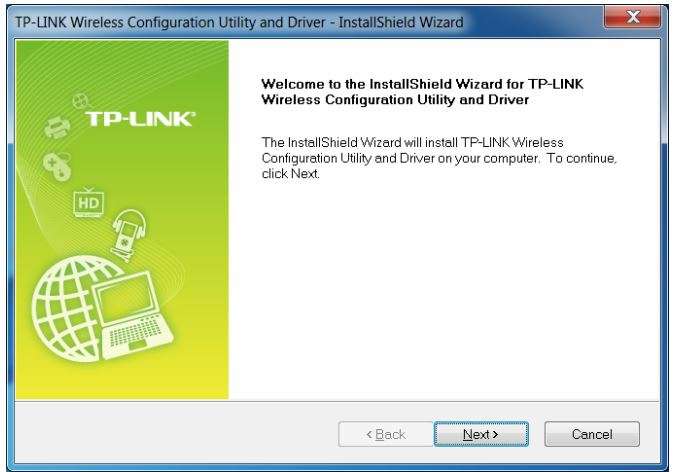
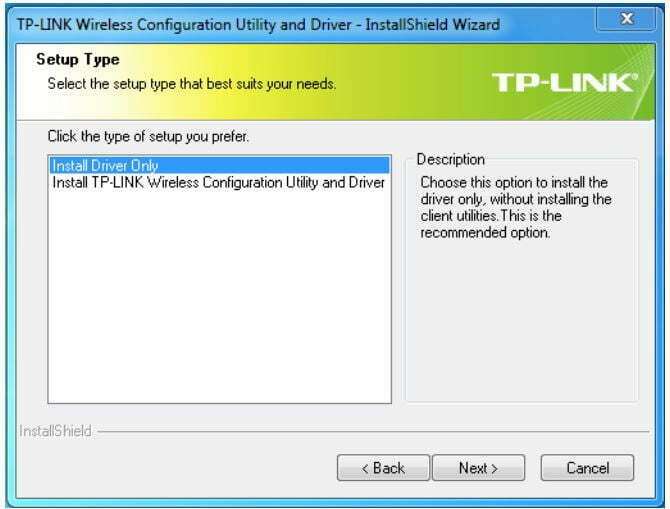 Note:
Note: (TP-LINK Utility icon). The Network screen displays.
(TP-LINK Utility icon). The Network screen displays.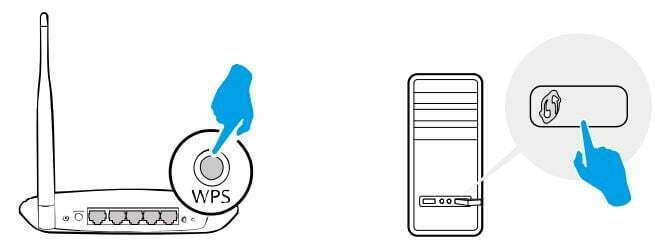
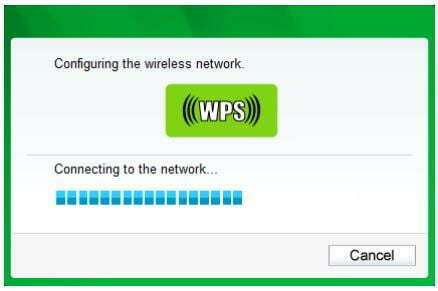
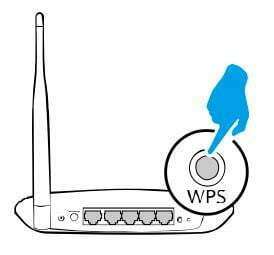
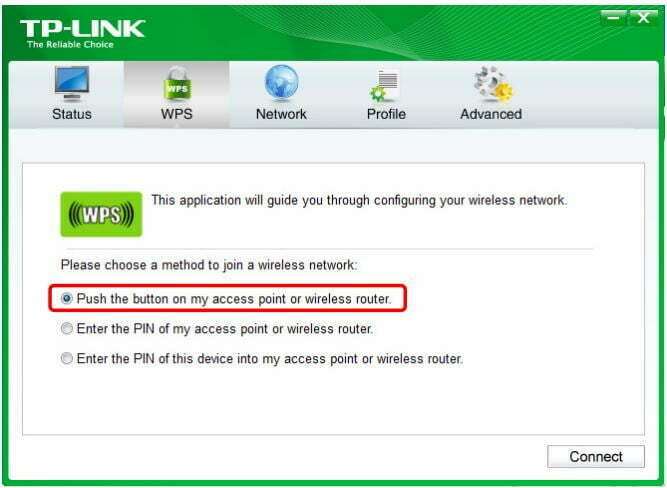
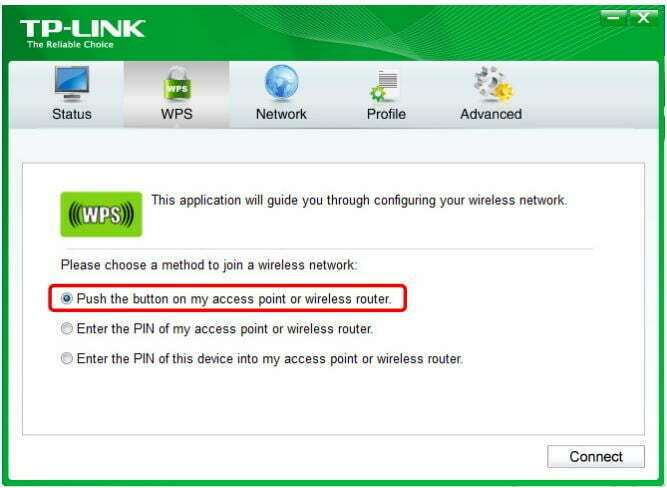
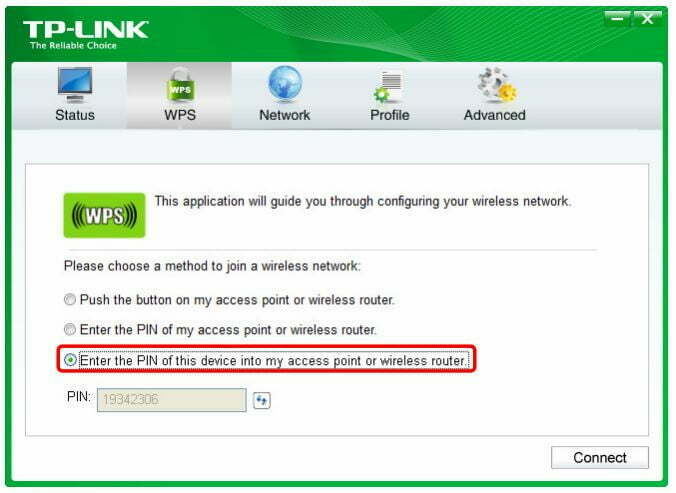
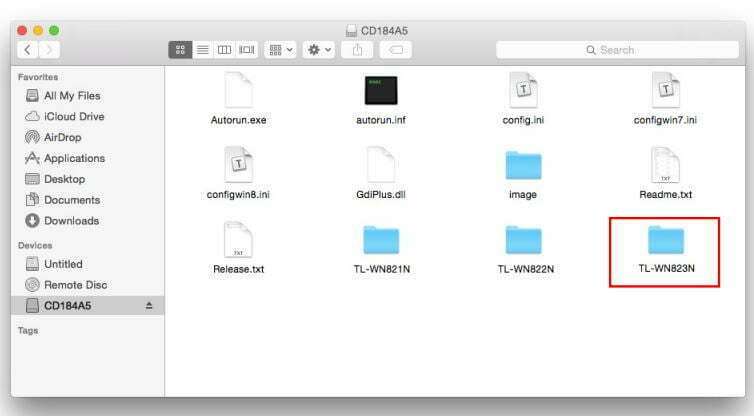
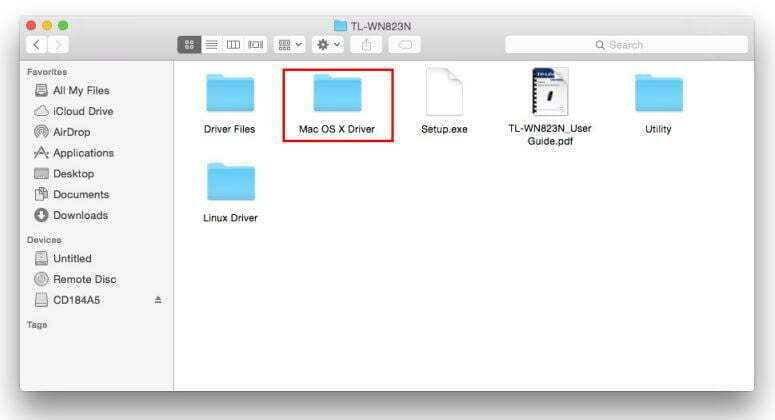
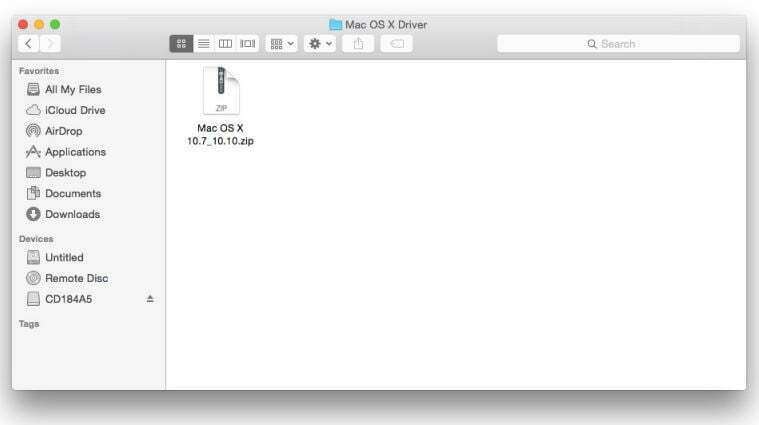
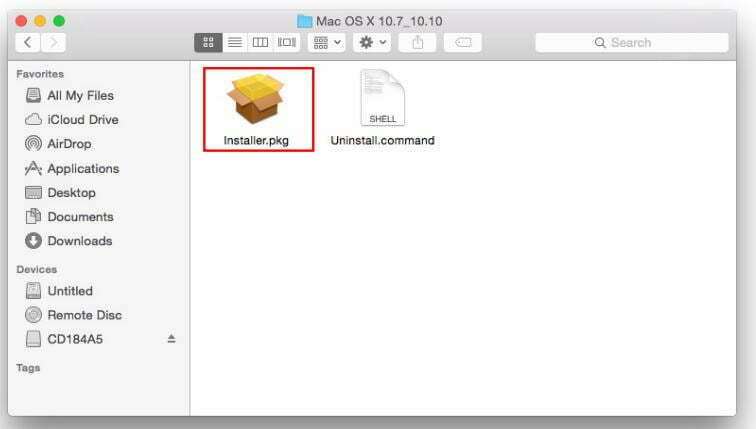
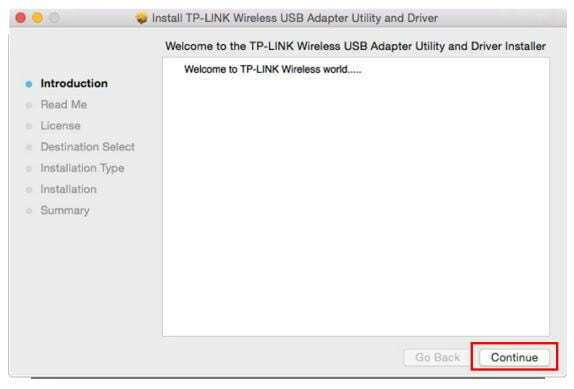
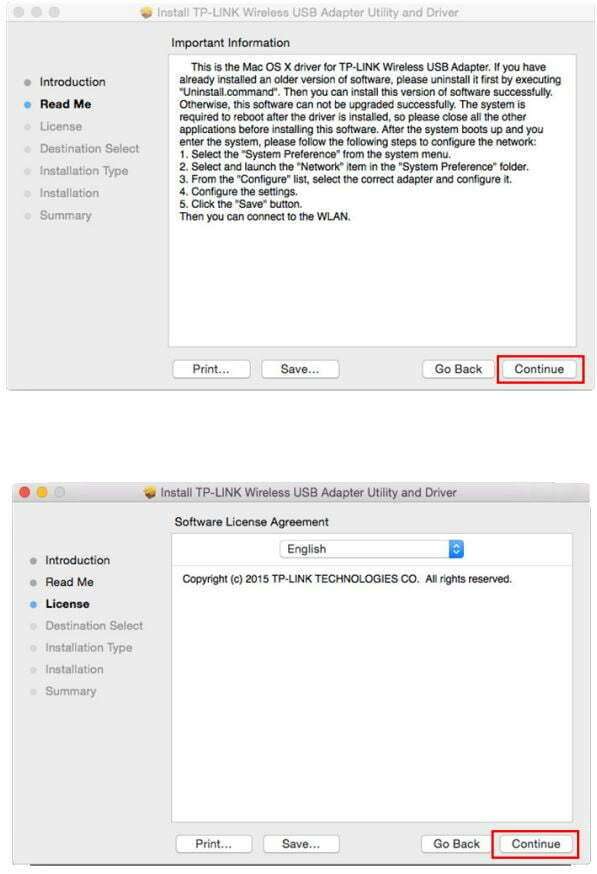 Note:
Note: